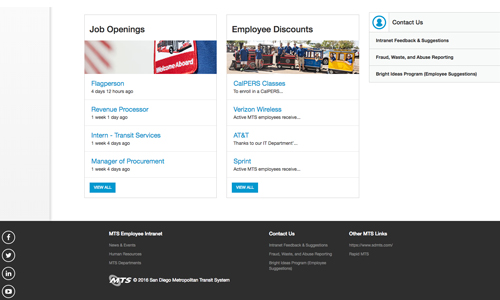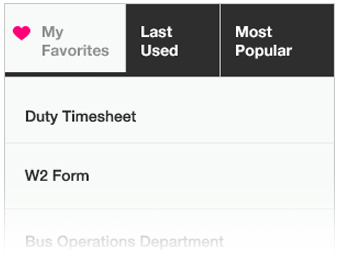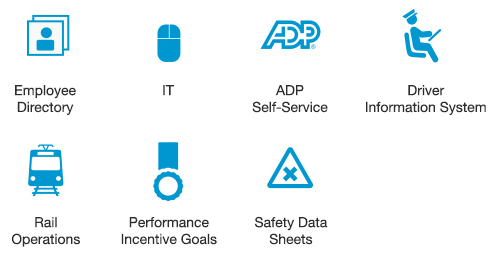You are here
Leaping Forward with Support Services
When agencies decide to implement an organizational restructure, add new leadership and implement new technology, there can be a dip in productivity as employees adapt to the new system and culture. All this change happened at MTS Support Services over the past three years. But instead of taking a step back to adjust, the 55 employees that make up the Support Services team took a leap forward and haven’t looked back.
Support Services handles more than 430,000 calls annually. And nearly 85% of those calls are answered within 15 seconds. Between the three call centers (Customer Service, Compass Card, MTS Information & Trip Planning) and the Transit Store, Support Services has vastly improved MTS customer service over the past three years in a variety of ways, including:
- 60% reduction in abandoned calls
- 79%reduction in call wait times
- 7% reduction in average time per call
“Two of the most important performance measures we look at are call wait times and the call abandonment rate to measure the customer call experience. Both performance indicators
have significantly improved,” said Manager of Support Services Amanda Denham, who oversees the five support services functions.
Denham has received high praise for bringing a renewed energy and enthusiasm to the Support Services team. She has redefined its role within MTS, and both Trolley and Bus Operations.
“Amanda and the Support Services team have re-energized our focus on providing high-quality customer service. It’s a success story that reflects what a team can do when it is focused and works well together,” said Bill Spraul, MTS Bus Chief Operating Officer.
According to Denham, the performance improvements have come from renewed commitment to the role and mission, streamlining the information available to the teams, improved response efforts and adopting better technology. But most importantly, she secured buy-in from Support Services employees early on. “It was important to explain why before what,” said Denham. “Adopting the new technology can be the easy part. The only way it works is if employees put it to good use. The team has to understand what it is we are trying to accomplish before diving into the tools.”
Denham’s leadership and new management approach coupled with the enhancements to the customer call centers’ databases have created an effective formula for MTS.
One of the most recent and best improvements came when MTS adopted SAP in January 2016. The agency opted to purchase an extra customer feedback technology feature called CRM that significantly enhanced monitoring, tracking and analyzing customer correspondence.
“Over the last year, we’ve been able to analyze more trends in the data than ever before,” added. Denham. “Now, MTS can understand customer feedback in a multitude of ways, such as by bus route, by rail line, time of day, and much more.”
“There have been substantial improvements,” said Revenue and Compass Card Manager Israel Maldonado who oversees the Compass Service center as well as Support Services’ team of farebox technicians and processors. “We’ve really been able to widen the communication channels between all our customer service points. This has helped improve the timeliness and consistency of each phone call, email and in-person response.”
Another big improvement came when the customer response obligation shifted from operations to customer service. Previously, operations would take call referrals from Support Services and interface directly with the customers. Now, Support Services handles the cases from beginning to end, providing a consistent presence for the customer and speeding up the response time.
And when MTS employees like Customer Service Supervisor Maria Sanchez assist customers from beginning to end, you know they are getting top-notch service. As an everyday transit rider herself with 21 years in Support Services, Sanchez is very much in tune with the riding experience. “I know what challenges customers face,” she said. “Sometimes customers are upset. But I can relate to them by sharing a landmark and describing the location where the incident took place. It really diffuses the tension.”
Most MTS functions are driven by performance data. Now that Support Services can take a deeper dive into the numbers, it will significantly help our understanding of the wants and needs of our most important asset – the customers. Having first-rate technology to digest all this data is important. But so are the employees who interface with each customer.
Tara Scott, MTS Information & Trip Planning Supervisor oversees the day-to-day operations of the busiest customer call center. Scott describes the working environment as a family-oriented setting. “We are very supportive of one another. The employees here bounce ideas off each other on best ways to answer questions from MTS customers. It’s a connected team,” she said. Just two years ago, the Information & Trip Planning team didn’t routinely have access to the Internet and primarily relied on internal materials, like timetables and route detour information, to help customers.
“It was important for us to have access to and comfortably use the same resources as the customer,” said Scott regarding the addition of the Internet. “We still trust all the same tools as before, but using things like the Internet and One Bus Away app help us understand what the customer is looking at.” With important buy-in from the five points of our Support Services team, improved technological features and seasoned professionals handling calls from start to finish, MTS is shining bright in the eyes of more customers than ever before.
The Five Points of Support Services
- MTS Information & Trip Planning (19 MTS employees) Handles the most calls and is the largest support servicesfunction. Employees working here have significant knowledge about the ins-and-outs of the entire MTS system.
- Customer Service (5 MTS employees) The customer’s ear for any issues they have riding the system. On a typical day, Customer Service receives more than 135 inquiries from customers through the website, voicemails and phone calls.
- MTS Transit Store (7 MTS employees) To many passengers and visitors, the Transit Store is the face of MTS. Employees handle a wide variety of requests from passengers such as SDM and Youth identification cards, timetables, brochures, lost and found, and commemorative and bulk pass sales.
- Compass Card Call Center (12 MTS employees) This team offers assistance with everything involving MTS fares – from registering Compass Cards for balance protection to explaining why a Compass Card won’t work with a hole punched through it.
- MTS Bus Revenue (12 MTS employees) This team of technicians and processors ensure the functionality of on-board fareboxes, maintaining and repairing this equipment so it works for our riders and operators, and accurately capturing fares and ridership.

 Employee Directory
Employee Directory IT Help Desk
IT Help Desk ADP Self-Service
ADP Self-Service Driver Information System
Driver Information System Bus Operations
Bus Operations Rail Operations
Rail Operations Performance Incentive Program
Performance Incentive Program Safety Data Sheets
Safety Data Sheets






